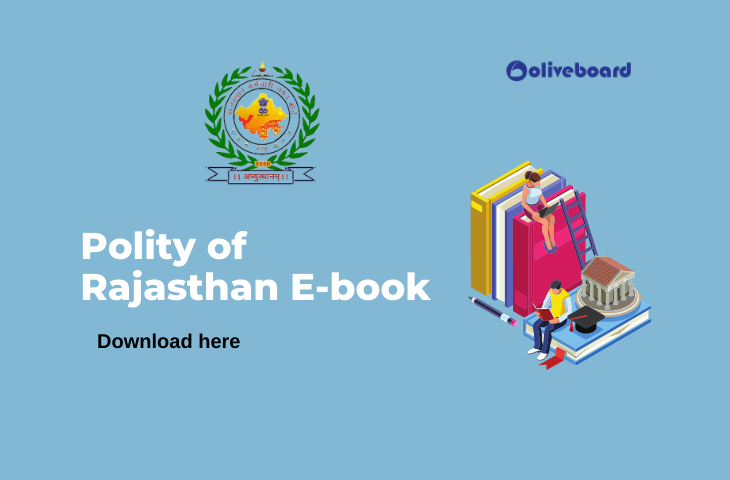Questions on Polity of Rajasthan are commonly asked in different Rajasthan state exams. It is one of the most important sections of General Knowledge. Get complete Polity of Rajasthan E-book – in this blog.
Use the link to download the free E-book from your Oliveboard dashboard.
How To Download The Free ebook?
- Click on the given download link. You will be taken to Oliveboard’s FREE Ebooks Page. Alternately, you can download the Oliveboard Android App to access these on your smartphone.
- Register/Login on to the Free E-Books Page of Oliveboard (It is 100% free, You just enter your valid email id and a password.
- After Login you will be redirected to the dashboard as shown below. Click on the free ebooks section at the left botton as shown below:

4. Now press Ctrl+F and type “Polity of Rajasthan” or “Polity of Rajasthan in Hindi”

5. You will be able to download the ebook.
Sneak peek into the Polity of Rajasthan E-book
The Constitution is the fundamental law of the land. It contains a set of rules, according to which the state is governed.
Constituent Assembly:
• It was M N Roy, who put forward the idea of the Constituent Assembly for the first time.
• In 1935, the Indian National Congress, officially demanded a Constituent Assembly to frame the Constitution of India.
• The concept of Constituent Assembly was included in the August offer of 1940, Cripps proposal of1942 and the Cabinet Mission Plan of 1946.
• In November 1946, Constituent Assembly was constituted as per the Cabinet Mission Plan. The Constituent Assembly was a partly elected and partly nominated body.
• Dr. Sachchidanand Sinha, the oldest member of the Assembly was elected as the temporary President and later Dr. Rajendra Prasad was elected as the President. Sir B N Rau was appointed as the Constitutional advisor to the Assembly.
• In December 1946, Jawaharlal Nehru moved the ‘Objective Resolution’ in the Assembly. Its modified version forms the Preamble of the Indian Constitution.
• To deal with the different tasks of Constitution making, the Constituent Assembly appointed different committees.
| Name of the important committee | Chairman |
| Union Powers Committee | Jawaharlal Nehru |
| Drafting Committee | Dr. B R Ambedkar |
| Committee on the functions of the Constituent Assembly | G V Mavalanka |
Enactment of the Constitution:
• The Constitution Assembly adopted the Constitution of India on 26th November1949
• The Constitution of India came into force on 26th January1950.
• Indian National Congress celebrated Purna Swaraj day on 26th January 1930. To commemorate this incident, the Constituent Assembly chose 26th January as the date of enactment of the Constitution.
Salient Features of the Constitution of India:
I. Lengthiest written Constitution
II. Drawn various sources: The Constitution of India has borrowed many of its features from the various Constitutions of the world
| S. No | Source | Features borrowed |
| 1 | Govt. of India Act – 1935 |
Federal Scheme, Office of Governor, Public Service Commissions |
| 2 | British Constitution | Rule of Law, Parliamentary form of Govt., Single Citizenship, Bicameralism, Legislative procedure, Cabinet System, Prerogative writ |
| 3 | US Constitution | Judicial review, Fundamental rights, Office of Vice-President, Independence of Judiciary, Impeachment of the President, Removal of Supreme Court and High Court judges |
| 4 | Canadian Constitution |
Federation with a strong centre, Vesting of residuary powers in the Centre, Advisory jurisdiction of the Supreme Court |
| 5 | Australian Constitution |
Concurrent List, Joint sitting of the two houses of the Parliament |
| 6 | French Constitution | Ideals of Liberty, Equality and Fraternity, Republic |
| 7 | Japanese Constitution |
Procedure established by Law |
| 8 | Soviet Constitution | Fundamental duties, Ideals of Justice (Social, Economic and Political) in Preamble |
| 9 | South African Constitution |
Election of members of Rajya Sabha, Procedure for amendment of the constitution |
| 10 | Weimar Constitution of Germany |
Suspension of Fundamental Rights during emergency |
| 11 | Irish Constitution | Directive Principles of State Policy, Method of election of President, Nomination of members to Rajya Sabha |
III. Federal Structure: This refers to the existence of more than one level of Government. For example,in our country, we have Central Govt. and State Governments.
IV. Parliamentary Form of Government
V. Integrated and Independent Judiciary
VI. Fundamental Rights: These are a set of rights given to citizens, which are fundamental in nature. This is to protect citizens from the absolute exercise of power by the State. There are 6 basic Fundamental Rights, and they are :
Glance of the Polity of Rajasthan E-book


Polity of Rajasthan E-book– FAQs
How can I download the Polity of Rajasthan PDF?
Register from the link here and download the Polity of Rajasthan PDF.
What topics are included in the Polity of Rajasthan PDF?
Topics included are all national and state polity – features of the constitution, Parts, articles, various organs of the State, different constitutional and statutory bodies etc.
